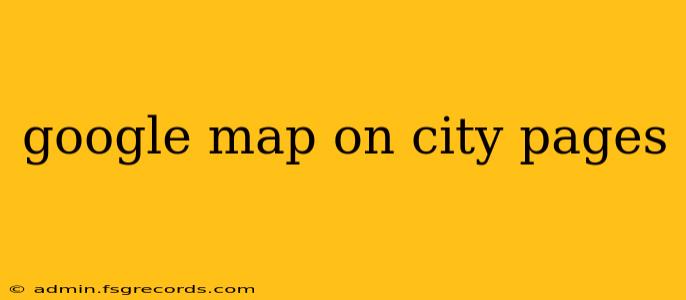Google Maps is no longer just a navigation tool; it's a powerful resource that significantly impacts user experience and search engine optimization (SEO). Integrating Google Maps directly onto city pages offers numerous benefits, enhancing both the visitor experience and the site's search ranking potential. This article delves into the strategic implementation of Google Maps on city pages, focusing on practical techniques and best practices.
Why Integrate Google Maps on City Pages?
Integrating Google Maps offers a multifaceted approach to improving your website's performance:
Enhanced User Experience
- Visual Appeal: A visually engaging map instantly provides context and enhances the overall aesthetic of your city page. Users can quickly grasp the location of key attractions, businesses, or points of interest.
- Intuitive Navigation: Maps allow users to easily explore the city's layout, find specific locations, and plan their visits. This improves navigation and reduces bounce rates.
- Interactive Exploration: Interactive maps encourage users to spend more time on your page, leading to increased engagement and potentially higher conversion rates (if you're promoting tourism or local businesses).
Improved SEO
- Increased Dwell Time: Engaging content, including interactive elements like Google Maps, encourages users to spend more time on your page. Longer dwell time is a positive SEO signal, indicating that your content is valuable and relevant.
- Improved Click-Through Rate (CTR): Visually appealing search results often have higher CTRs. The presence of a map in your search snippet can significantly boost click-through rates from search engine results pages (SERPs).
- Schema Markup Enhancement: Properly implementing schema markup with your Google Map enhances the structured data provided to search engines, leading to richer search snippets and better indexing. This helps search engines understand the context of your content better.
- Local SEO Boost: For city-specific pages, Google Maps integration is crucial for local SEO. It helps your page rank higher in local search results, attracting users actively searching for information about your city.
Best Practices for Google Maps Integration
Effective Google Maps integration requires careful planning and execution. Here are some best practices:
Choosing the Right Map Type
Consider your city page's purpose and audience. A simple map showing major landmarks might suffice for a general overview page, while a more detailed map with points of interest and interactive elements might be better suited for a tourism-focused page.
Optimizing Map Markers
Clearly label map markers with relevant keywords. Use descriptive names that accurately reflect the location and its significance. This helps with both user experience and SEO. Ensure consistency in naming conventions.
Contextualizing the Map
Don't just embed a map; integrate it seamlessly into your content. Provide context by referencing specific locations mentioned on the map within your text. This improves user understanding and demonstrates to search engines the relevance of your map.
Utilizing Schema Markup
Implementing schema markup for your map enhances its visibility in search results. Use the LocalBusiness or Place schema types depending on the context, providing additional information about the locations marked on the map. This allows Google to better understand the content and improve your ranking.
Responsive Design
Ensure your embedded map is responsive and adapts seamlessly to different screen sizes and devices. A poorly displayed map on mobile devices can significantly impact user experience.
Conclusion
Integrating Google Maps strategically into your city pages offers significant advantages for both user experience and SEO. By following best practices and focusing on seamless integration and optimization, you can leverage the power of Google Maps to enhance your website's performance and attract more engaged visitors. Remember, consistent optimization and monitoring of your map's effectiveness are key to achieving long-term success.

